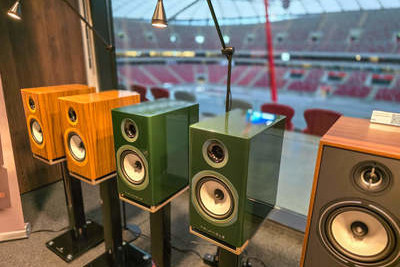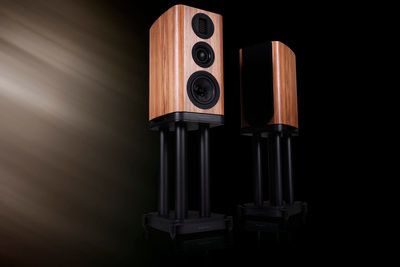
At the end of 2020, after a shop visit in The Hague, I went for a drink at the home of my fellow hifi-editor Rene van Es, who lives nearby. A vaguely familiar-looking amplifier caught my eye when I took a peek at the set in his secondary listening room. I did not quite recognize it, but the front panel and the cage curving backwards over six 12AU7 tubes told me: PrimaLuna. But the significant, fully covered cabinet behind those 12AU7's with no visible power tubes was telling a very different story... | Voor Nederlands, klik hier
While I was staring at it with my mouth open in surprise, because the most likely truth was slowly emerging on me, René said: 'You will have to keep that a secret for a while, but yes, that is a new hybrid integrated amplifier from PrimaLuna. Herman asked if I wanted to listen to it, and I'm pretty much done with that. So I talked to him this afternoon and asked if you could take it home to listen to it as well and compare it with your PrimaLuna EVO400 integrated.'
After I finished my happy dance, we put it in the trunk of my car, and I raced home to set it up. A few weeks later, when the amplifier had been picked up by one of Herman's employees, I was blissfully unaware that the enthusiastic listening report I emailed to Herman would get a sequel. A unique sequel. When the Dutch PrimaLuna distributor More Music asked me to write a review of this amplifier - to coincide with the worldwide introduction - I suggested that René and I co-write it. After all, I had him to thank for the beta testing.

After some deliberation with the publisher and the chief editor, we decided on a twin review. René would focus on the technical aspects, and I would go deeper into the listening experience. René and I agreed not to discuss our listening experiences before we were finished writing because we did not want to influence each other's opinions about the amplifier. That was harder than we thought because we already knew that we both loved it, but we succeeded. Therefore, any similarities in our findings are purely coincidental. Or are they the result of the apparent qualities of this amplifier after all? Judge for yourself …
Some technology
I'm not going to steal my colleague's thunder with a repetition of moves about technology. If you want to know more about the 'Floyd' MOSFET amplifier design by former Sphinx engineer Jan de Groot, read René's review. However, there are two aspects that I would like to mention because they clarify the differences between tube amplifiers and solid-state amplifiers. And because they explain a considerable part of my listening experiences.

The main difference is that most tube amplifiers work with an output transformer that converts the high voltage and low current from the power tubes to a low voltage and higher current to drive the speakers. In addition, the output transformer stops DC voltage, which is very important if you do not want to ruin your speakers. In a nutshell, the better the output transformer, the better the tube amplifier can sound. PrimaLuna manufactures its output transformers, and their amplifiers are famous for sounding exceptionally good.
Another advantage of an output transformer is that you can optimize the output signal to match the impedance of the connected speakers. Most tube amplifiers have a separate plus pole for 4 Ohms and 8 Ohms speakers, and some also have a 16 Ohms tap. However, an output transformer has a particular disadvantage as well. It increases the output impedance of a tube amplifier quite a bit, resulting in a low damping factor. Now, the damping factor (the extent to which the power amplifier has the loudspeakers 'in its grip') is of more importance with solid-state amplifiers than tube amplifiers.
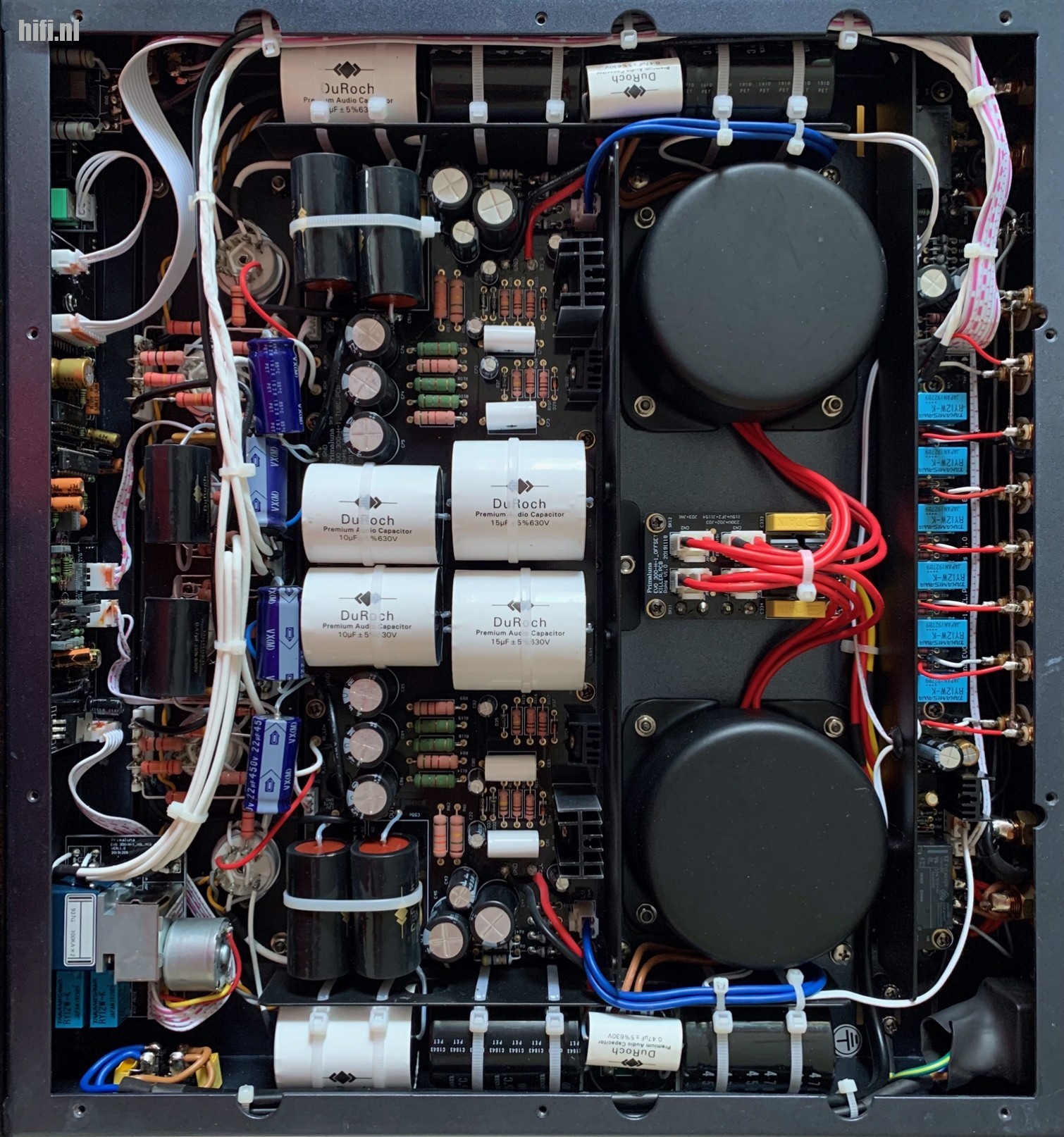
Still, it is a known fact that the bass from a tube amplifier with output transformers sounds different than from most solid-state amplifiers. Not less deep or powerful, provided that suitable output transformers are used, but rounder and often a bit less tight. A tube amp is probably not your best choice if you are a real bass fetishist who likes to experience earthquake disaster movies at wall-crumbling volume levels. However, if you like a lot of realism and timbre in acoustic instruments and voices, or if you want to tune the sound of your amp by 'rolling' in other tubes, then a tube amp is definitely for you.
That is difference number one. The second difference is difference 1a. A solid-state amplifier does not need an output transformer, so the speaker outputs are universal. You do not have to worry about the impedance of the loudspeakers you connect.
Listening to the PrimaLuna EVO 300 Hybrid Integrated
When it became clear that I would review this product, the EVO 300 Hybrid was returned to Eindhoven at my request because it had been a few months since the first listening impressions. It replaced my PrimaLuna EVO400i (with PrimaLuna EL34 power tubes and the stock PrimaLuna 12AU7's in the gain-stage) in a set that consisted of a restored Thorens TD125 with Jelco SA-750E 10-inch arm, fitted with a Holistic Audio HA-103C cartridge in an AudioTechnica AT-LH15/OCC headshell. An AudioCreative PhonoDude tube phono stage with Cinemag step-up transformers and an AURALiC ALTAIR G1 streamer connected to an English Electric 8Switch with iFi iPower power supply.
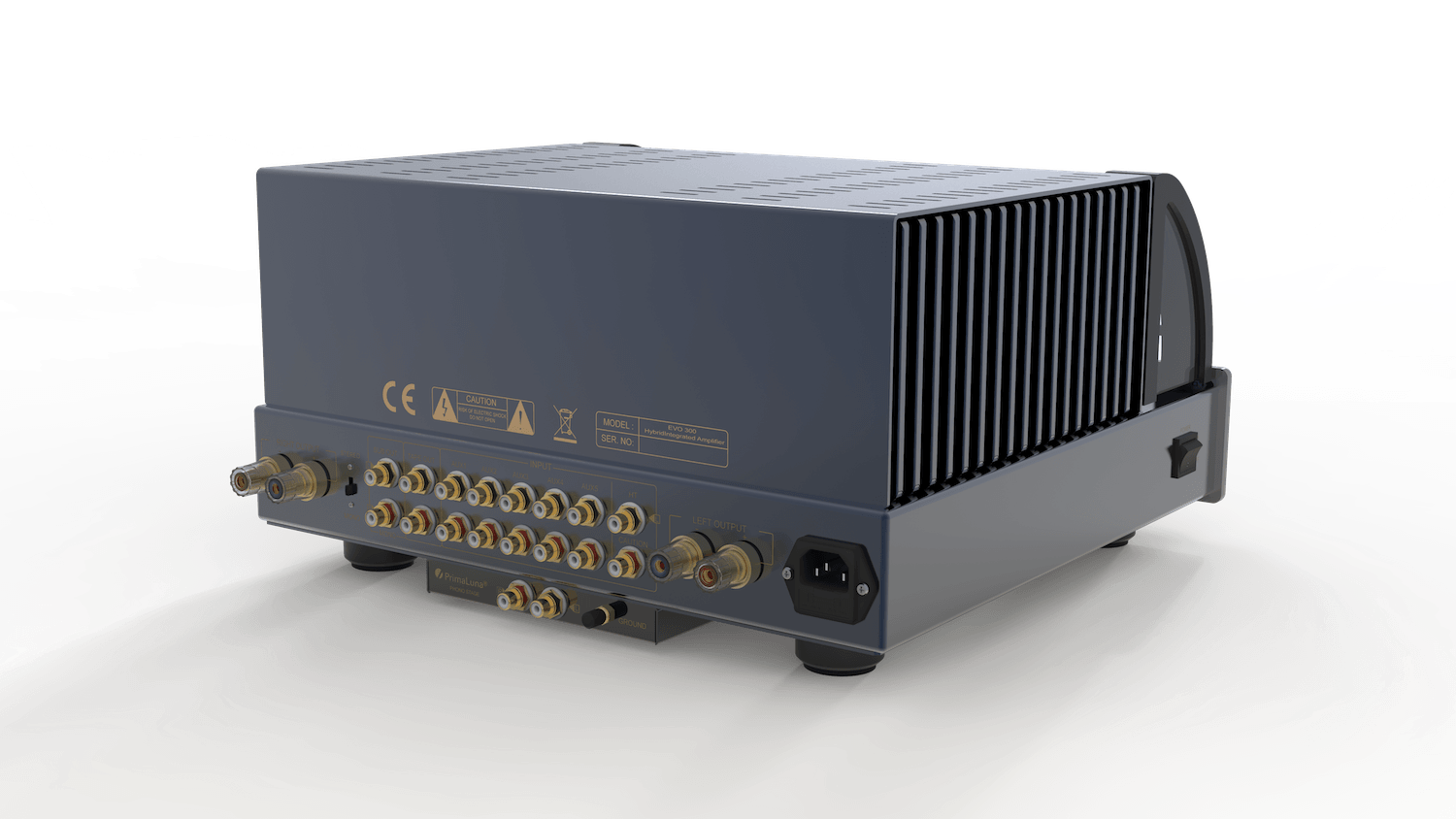
Most of my listening was done with my Kharma Ceramique prototype speakers and a pair of Elipson Heritage XLS15 – that were in for a review – and I used my KEF LS50 Anniversary Editions as well. All cabling was from AudioQuest. What comes next is a summary of both times I listened to the amplifier.
First encounter
After casual listening for warm-up, mainly reproducing television audio, I started the first serious listening session shortly before Christmas. Because it had been on heavy rotation in my playlist for a few weeks, I chose the new album In Velvet by the Belgian group Nordmann to go first. The exciting and complex mix of post-rock, (post)jazz, and psychedelic electronics was recorded in a wonderfully warm and spacious way, with lots of dynamics by today's standards. I noticed how much the PrimaLuna EVO 300 Hybrid Integrated resembled my 'full tube' EVO400i. There were apparent differences too, more about that in a moment. Still, the timbre, the representation of space, and the involvement I felt with the music had a clearly tube-like character due to, I was told, the use of MOSFETs in the power amplifier. Rich, expansive, and somehow just 'right'.

The family resemblance was more than evident - something I had hoped for, to be honest, but had been cautious to expect. Mattias De Craene's spitty sax at the beginning of the track Jade was almost tangible. It appeared to stand between the speakers at the correct height, surrounded by a cloud of reverberating guitar and subtle percussion. Goosebumps? You bet! Not unexpected was the distinctly different low-frequency response, which was more precise and – indeed – a bit more robust. The kick drum, in particular, became more prominent in the mix.
Second listening session
One of my favourite tracks to test the bass response of an amplifier is Path 1 on the album Labyrinth by Pete Namlook and Lorenzo Montana. This electronic garden of wonder contains some really deep bass that makes my sofa vibrate when the volume is set correctly. With the EVO400i, the bass is quite remarkable, but the very last bit of 'push' is missing. No matter how loud I play it. The EVO 300 Hybrid Integrated did better. A lot better. That became obvious when my better half, sitting next to me, said: 'Can you turn it down a bit? The couch is shaking!'
Fortunately, in addition to the super-fat bass, more exciting stuff is going on in this track. After 90 seconds, a percussive sound is added to the almost holographic mix. It resembles a tap on a woodblock but with an added delay that creates an echoing effect. This sound can be heard intermittently during the 19 plus minutes of the track, and it has become something of an obsession for me. On a good hifi-set, you can hear that each occurrence has a slightly different tonal structure, and they all have a different attack as well. But most importantly, they are all in a different position in the mix. Some are further forward, and to the left, some are further back and more to the right, and the rest are in various places in between.

One could draw a straight line between them that runs diagonally from left to right with some imagination. The better you can hear this, the better the set performs in terms of timing and phase integrity of the stereo signal. The EVO 300 Hybrid hit a home run in this regard.
Listening with the Elipson Heritage XLS15
Although this review is not about the Elipsons, they are definitely worth a brief mention. Based on their 92dB efficiency, I had expected that my EVO400i would have no problem driving them, but I struggled to get their tonal balance right in my relatively small listening room. The EVO 300 Hybrid had much better control over these interesting retro speakers' 12-inch white cellulose pulp woofers. Spaciousness, which had been quite nice with the EVO400i, to begin with, was even better with the EVO 300 Hybrid.

The highest frequencies were more extended, but the Hybrid had the same subtlety, refinement, and harmony that I love about my full-tube amplifier. Modern classical music, such as the Affanoso from Arvo Pärt's Symphony No. 4 ("Los Angeles"), was reproduced with loads of wonderfully palpable spaciousness. This recording on ECM New Series has a high sense of being there, and the Hybrid succeeded – convincingly – in coaxing that from the Heritage XLS15's wide-baffle mounted drivers.
Listening with the KEF LS50 Anniversary Edition
Typically, I spend many hours a day in my office listening to these remarkable speakers, which are powered by a Peachtree Decco65, a hybrid Class D amplifier that isn't a true hybrid because the single ECC88 tube in it acts more like a parallel' tubifier' that can be switched on and off. It sounds excellent nonetheless, and the nearfield set up in my office, the LS50s, sound vary spacious, with deeper bass than their modest specifications suggest. When I take them downstairs and place them on my critically damped Norstone Stylum 60 stands, they project an enormous spatial image, but the 'sparkle' in the high frequencies remains a little underexposed when I power them with my EVO400i. The PrimaLuna EVO 300 Hybrid Integrated did a lot better.

The same insanely large sound stage, but with more detail. The LP version of Shimmer Into Nature, the most recent solo album by Ozric Tentacles frontman Ed Wynne, sounded incredible. The music, an instrumental mix of electronic space rock, eastern mysticism, and virtuoso guitar work, is very similar to that of the Ozrics, but it has a more relaxed and polished vibe. The LS50's completely disappeared from the sound stage, and I was immersed in a magnificent bubble of sound. And that is as much to the credit of the EVO 300 Hybrid as it is to the point source Uni-Q drivers in the LS50's.
Tube Rolling with the EVO 300 Hybrid Integrated
As I mentioned earlier, many tube amp owners - myself included - enjoy putting different tubes in their amps. This way, the sound can be tuned to our taste or the acoustic properties of our listening room. We call this 'tube rolling'. When I had just switched back to tubes, this was quite a thing to me, but after finding the 'perfect combination', I was pretty much done with it. My tube rolling experiments focussed mainly on the 12AU7 double triodes in the gain stage of my EVO400i. The tubes you put in the gain section usually make the most significant difference in a full-tube amplifier, much more than the power tubes or drivers/phase splitters. But what would tube rolling bring me in combination with a MOSFET output stage? The preamplifier section in the EVO 300 Hybrid Integrated looks very similar to my EVO 400i, so I was expecting quite a lot from it.

But unfortunately, this turns out to be a bit of a disappointment for fanatical 'rollers'. The differences I heard with various NOS pairs of ECC82/12AU7, CV491, 5814A, or 5963 were minimal to begin with, and none of them was an improvement over the stock PrimaLuna tubes. Not the incredibly holographic but somewhat lean sounding Tesla ECC802S's, nor the fairly warm sounding Raytheon JAN-CRP 5814A's, the beautifully balanced Toshiba 12AU7A's or the Mullard-built Philips Miniwatt CV491's with their glorious midrange; every time I put the PrimaLuna tubes back in, the music became more real and believable.
PrimaLuna boss Herman van den Dungen, 'Floyd' designer Jan de Groot and the PrimaLuna engineering team in China spent two years working on the hybrid combination of the tube pre-stage and the 'Floyd' MOSFET output stage. So it didn't surprise me that – in the end – the stock tubes performed best. Some will be disappointed, but I find that quite reassuring. PrimaLuna branded tubes are from current production, so they can be replaced quickly and affordably when their time has come.
Conclusion
The PrimaLuna EVO 300 Hybrid Integrated is a terrific amplifier. First of all, because it sounds like a PrimaLuna. As far as I was concerned, that was arguably the number one requirement. Secondly, because compared to the EVO400i, it adds control and power to the bass. Thirdly because it is built like a PrimaLuna. And finally, because it uses a beautiful and innovative Dutch amplifier design.
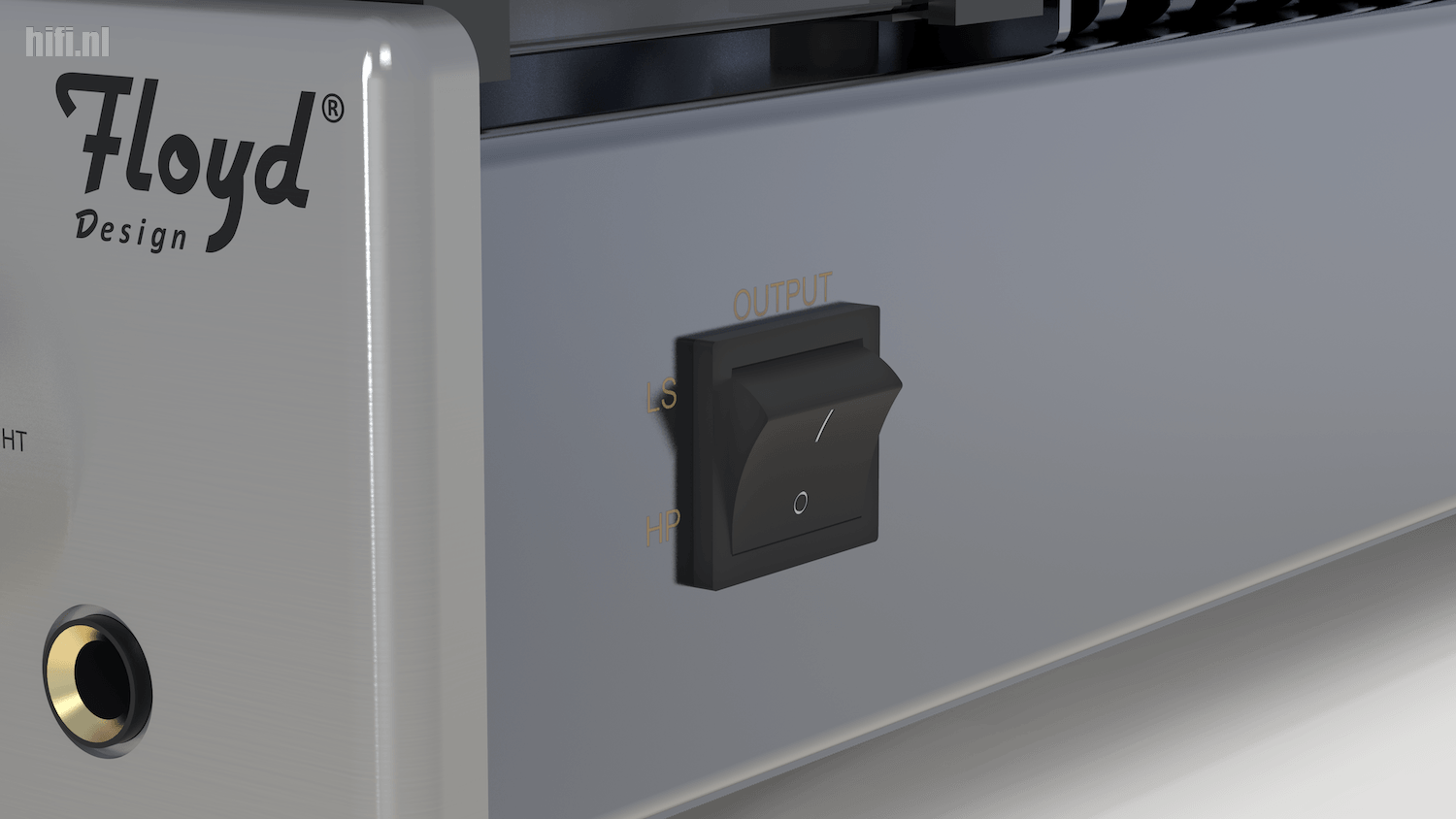
The Floyd concept in the EVO 300 offers the best of both worlds in a very successful way, retaining the strengths of both. Shortly before I completed this review, I learned the recommended retail price, and I would say it is pretty competitive compared to international high-end products. PrimaLuna may not have the allure and heritage of some old and venerable American and Japanese high-end brands (yet). Still, in terms of sound quality, construction, component selection, reliability, durability, and service, they easily hold their own. The way this amplifier positions itself sonically is a matter of taste, in my opinion, not of absolute sound quality. However, the EVO 300 Hybrid Integrated sounded like music to my ears. This is world-class Dutch Design!
I am unaware of any plans to expand the Hybrid line further into the PrimaLuna range, but maybe a power amplifier first, if I may be so bold as to make a suggestion … In any case, this PrimaLuna EVO 300 Hybrid Integrated will undoubtedly cause quite a shock among fanatic PrimaLuna owners. In the friendly and lively Facebook group of PrimaLuna Amplifier Owners, people have been openly dreaming about PrimaLuna Single Ended Triode amplifiers or a full-tube phono stage for the last few years. Still, no one would have seen this coming. However, I dare anyone who is currently using a PrimaLuna tube preamp and a solid-state power amplifier from another brand to compare it to this EVO 300 Hybrid and listen with an open mind. And be prepared to spend less money on vacation for the next couple of years.
PrimaLuna EVO 300 Hybrid
€ 6.975 | zilver of zwart front | primaluna.nl | moremusic.nl
You can find our second PrimaLuna EVO 300 Hybrid review here

